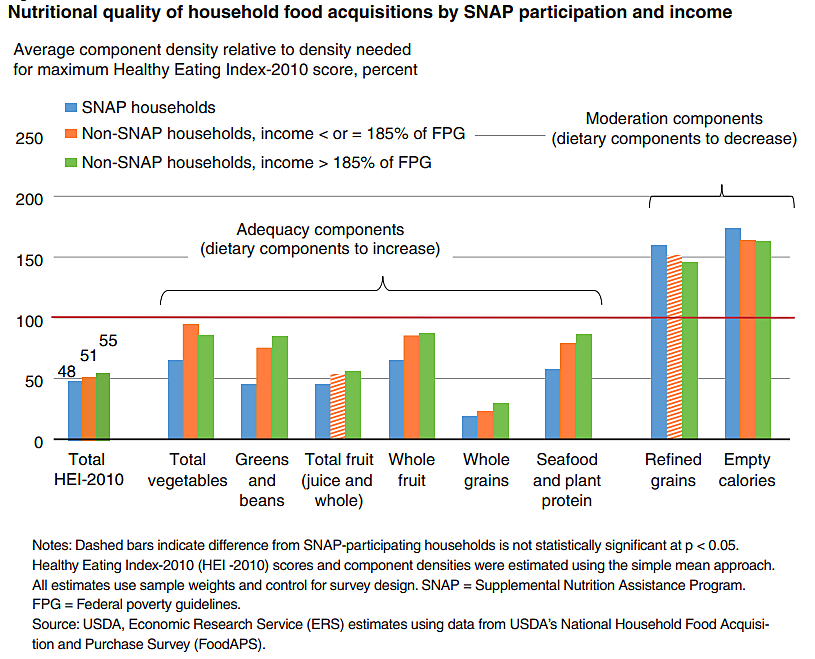Spending on the Supplemental Nutrition Assistance Program (SNAP) has doubled since 2019 to $127 billion in 2023. Such spending increases are raising federal budget deficits to unsustainable levels. Policymakers need to cut, and one place to start is programs that do not work as promised. With SNAP, the N is for nutrition, but SNAP households have less nutritious diets than other households.
The SNAP page at the U.S. Department of Agriculture (USDA) says, “SNAP provides nutrition benefits to supplement the food budget of needy families so they can purchase healthy food.” This USDA document promotes, “Increasing SNAP Benefits to Support Healthy Eating Patterns at All Life Stages,” and it mentions “nutrition” 199 times. A study by the Center on Budget and Policy Priorities says, “SNAP helped about 42 million low-income Americans afford a nutritious diet.”
However, SNAP households tend not to “purchase healthy food,” nor do they have “healthy eating patterns” or “nutritious diets.” A 2016 USDA study found that 23 percent of SNAP spending is on what can be called junk food.
More evidence comes from a 2018 USDA study. This chart from the study shows that nutritious foods make up a substantially smaller share of food acquired by SNAP households than other households.
The chart is based on a detailed USDA survey and analysis of Healthy Eating Index components for three groups: SNAP households, non-SNAP lower-income households, and non-SNAP higher-income households. The income level separating the two non-SNAP groups is 185 percent of FPG (federal poverty guidelines).
The analysis found that SNAP households receive about the same overall calories as other households, but:
Compared to lower income nonparticipants, SNAP-participating households acquired 31 percent fewer total vegetables, 40 percent fewer dark green vegetables and beans, 24 percent fewer whole fruits, 20 percent fewer whole grains, and 27 percent fewer seafood and plant proteins for every 1,000 calories acquired. They also acquired almost 6 percent (33.05/31.09) more empty calories as a share of total calories.
SNAP households bought less healthy foods than other lower-income households. The USDA study concludes, “Compared to the SNAP-nonparticipating subgroups, SNAP-participating households purchased foods of lower quality overall.” The study only examined correlations, not causations, but the results are similar to other studies: National Health and Nutrition Examination Survey data “also show that diet quality among SNAP participants is lower than among nonparticipants.”
Advocates often say that SNAP households have poor diets because they do not have nearby access to healthy foods. But the 2018 USDA results do not support that theory: “Further, on all of our measures of nutritional quality, SNAP-participating households with low household-level access to food stores did not differ from SNAP-participating households with better access.”
Policy Implications
The USDA says that “Poor nutrition is a leading cause of illness in the United States, associated with more than half a million deaths per year.” Yet the USDA’s largest food program, SNAP or food stamps, delivers poor nutrition. This is a major policy failure, especially since SNAP costs taxpayers an enormous $127 billion a year.
SNAP is part of the Farm Bill scheduled to be reauthorized this year, and so policymakers should explore ways to cut the program. One option is to replace the $127 billion program with a “Fruits and Vegetables Program,” which would cost $20 to $30 billion a year (see data note below). Nutritionists disagree about some foods, but they all agree that fruits and vegetables are essential. Taxpayers would save about $100 billion a year replacing SNAP with an F&V program.
Another option is to devolve SNAP to the states and let them decide how to reform the program. State policymakers are better placed to decide on the level of benefits and foods to support. The states alongside the private sector have more flexibility to find efficient solutions.
Unfortunately, SNAP’s nutrition failure has so far only prompted the usual response to federal failure—add more programs! Congress has added SNAP-Ed and the Gus Schumacher Nutrition Incentive Program to promote healthy food choices. These add-on programs cost taxpayers about $550 million a year. Last year, the Biden administration issued a “National Strategy on Hunger, Nutrition, and Health,” which proposed new subsidies and regulations to induce SNAP recipients and others to eat healthy.
But rather than building the federal food bureaucracy larger, policymakers should replace SNAP with a smaller Fruits and Vegetables Program or devolve it to the states for more innovative policy solutions.
For more on SNAP, see here and here.
Data Note: the 2016 USDA study found that fruits and vegetables were 14 percent of SNAP benefits, which would be about $18 billion in 2023. Replacing SNAP with a Fruits and Vegetables Program would likely increase consumption of those healthy items, perhaps to $20-$30 billion a year.

